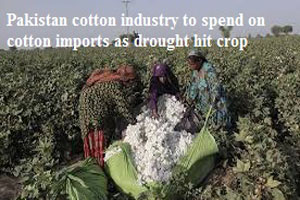
Pakistan cotton industry to spend on cotton imports as drought hit crop
YarnsandFibers News Bureau 2016-05-13 13:00:00 – IslamabadBad weather has hurt both the quality and quantity of cotton harvested, leaving Pakistan’s textile producers struggling as they face lack of supply and higher prices for import. The textile producers account for almost nine percent of GDP. To support its ailing textile industry after erratic rainfall and drought, Pakistan is spending $4 billion a year on cotton imports.
Mehmood Aslam, operations manager at Fazal Group, one of the oldest and largest textile groups in Pakistan, with operations in cotton ginning, yarn and fabric manufacturing said that they are importing cotton from India and some other countries to fulfill their demand and this has increased to 20 percent in just six months.
Turning to imports had led to a rise of up to 30 percent in the cost of the company’s raw materials and hit the company’s profits.
The quality of the Pakistani cotton still available also is declining as a result of the poor conditions.
The local cotton contains a lot of trash and other contaminations due to the extreme weather conditions. Therefore its ginning yield has fallen and production costs have escalated.
He said that the problems sourcing good quality cotton and ongoing energy shortages in Pakistan had reduced his company’s exports of finished textiles from more than 100 shipping containers a month over much of the last two years to out 30 containers today.
They can’t meet the deadline of 30 days to deliver their orders and the majority of their clients have turned to India, Bangladesh and China to get their orders done in time.
The government has been urged to offer reductions in sales tax to help the struggling industry.
According to the Federal Committee Cotton on Agriculture (FCC), a department of the Ministry of Textile Industry, this year, Pakistan’s cotton production has fallen from a predicted 15.5 million bales to 10.9 million bales as a result of erratic rainfall, drought in some cotton-growing areas and poor seed quality.
Pakistan’s Punjab province produces around 85 percent of the country’s cotton, with Sindh province growing much of the rest.
Khalid Abdullah, the country’s Cotton Commissioner and vice president of the Pakistan Central Cotton Committee, said that the country will spend around $4 billion on import of the cotton to meet its domestic demands this year.
Low prices for cotton last year helped drive down production and weather extremes related to climate change, as well as insect attacks, also hit harvests. Climate change and extreme weather patterns are a major blow to the crop.
Pakistan is the fourth largest producer of cotton in the world, behind China, India, and the United States, and has the third-largest spinning capacity in Asia after China and India.
The cotton industry provides employment to some 40 percent of Pakistan’s industrial workforce, according to a report published by the Institute of Cost and Management Accountants of Pakistan. It says Pakistan also earns around $12 billion annually from export of cotton and cotton products.
To deal with worsening drought and falling cotton harvests, Pakistani scientists at the Central Cotton Research Institute are developing 45 new drought-tolerant and heat-resistant cotton seed varieties with the help of private seed companies.
The aim is to not only keep up cotton production but to reduce the amount of irrigation water needed to grow cotton.
Khalid Mahmood, director of the Cotton Research Institute Faisalabad, said that the new seed varieties have been planted at 22 locations in Punjab and Sindh provinces on a trial basis.
Trials will continue another two years, he said, then the seeds are expected to come onto the market once they are approved by the Punjab Seed Corporation, a semi autonomous body of the Punjab government that will look at their quality and ability to resist extreme weather patterns, he said.
The varieties in trials are producing 40 maund of cotton per acre — at least a third higher than normal cotton harvests — and cutting water use by 30 percent.
They hope the new seed varieties will help increase the overall cotton production around 20 percent and save a lot of foreign exchange reserves being spent on import of cotton.
Market Intelligence
Ask for free sample Report

experience
Customer Base
dedicated team
Countries Served Worldwide









